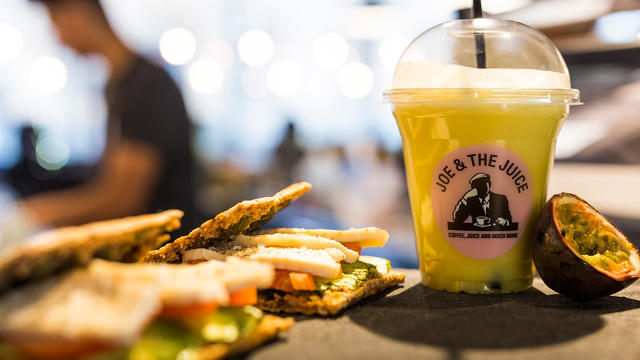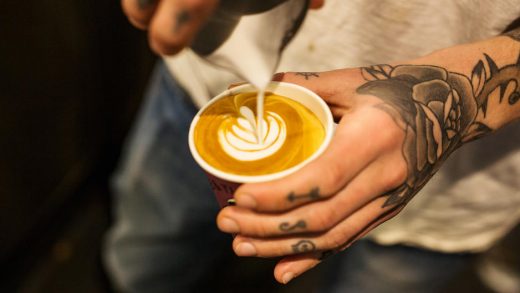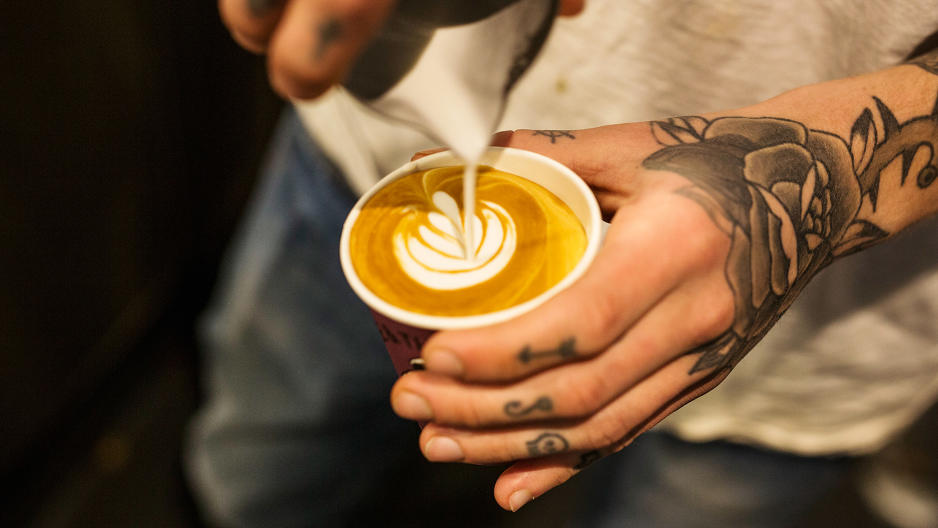Coffee, Sandwich, And A Side Of Edgy: How Joe & The Juice Aims To Take Over The U.S.
Here are some things you likely won’t find at Joe & The Juice, the Danish franchise that’s like a Starbucks, Jamba Juice, and Le Pain Quotidien all rolled into one: scripted cashier greetings, bathroom codes, or a generic easy-listening soundtrack on a loop.
And here’s what you probably will encounter: a lively staff that makes an effort to connect with customers and, by blasting an idiosyncratic playlist, for instance, gives the place a distinct vibe. Vibe—now that’s a term rarely associated with food and beverage chains.
“The music is always so fun, as well as the staff,” reads one Yelp review. Another notes: “The spirited young boys behind the counter were rugged, good looking, sexy, fast, and efficient while engaging in a fraternal banter that set a good energy . . . this place has the vibrancy and fun feel of a bar.”

That’s exactly what Joe & The Juice is going for. Founded in 2002 by Kaspar Basse, a former professional karate champion from Denmark, the company is establishing itself as the go-to place for health-conscious people who like their fresh-pressed juice served with a side of edgy. The locations usually offer a spacious communal area outfitted with slick midcentury furniture, bright art, book-lined shelves, and a free photo booth. Joe & The Juice sells coffee, tea, sandwiches, fresh juices, smoothies, and veggie shots made with organic ingredients and prepared on the premises. You have your pick of juices like Hangover Heaven (apple, elderflower, mint), Go Away Doc (carrot, apple, ginger), and Sex Me Up (passion fruit, apple, ginger).
For Lars Bo Hansen, the senior executive director at Valcon Management Consultants who used to consult for Joe & The Juice, everything rides on the in-store experience. “It is the ambience and the emotional factors that differentiate them,” he says. “Obviously, the products are healthy, but the freshness and the vibe combined makes it unique.”
With more than 170 branches in 14 countries, Joe & The Juice has big ambitions. You can spot them all over Europe, in trendy neighborhoods or places with heavy traffic like Reykjavík-Keflavík Airport. There are currently five U.S. stores in San Francisco, New York City, and most recently, Miami. But that’s just the beginning: Several hundred more locations are slated to open in the U.S. in the next few years. General Atlantic, a leading growth equity firm, announced a strategic investment in the company in October 2016 to fuel its North American growth.
Ask Basse what the key is to rapid, successful expansion and he’ll tell you it all comes down to one thing: hiring the right people.
The “Casting” Process
As a former athlete, founder and CEO Basse understands the importance—and draw—of nutrition. When he started to kick around the idea of launching his own company, he realized he loved the concept of Starbucks, save for two big omissions: the lack of freshly prepared healthy food and a distinctive atmosphere.
“We are probably the only ones to deliver three categories [coffee, juice, and food] without being a restaurant,” Basse says. “We deliver a more intimate, inspiring atmosphere and more nutritious, better tasting products than most of our competition.”
The U.S. market seems ripe for an efficient chain that can offer more than just plastic-packaged tuna sandwiches. But with Joe & The Juice, it’s not just what’s served—it’s how it’s served. And that’s where the employees come in.
The staff, called “juicers,” are encouraged to be themselves in how they dress and talk, and even to play their own music. They’re given control of their stores, and in return, treat it as such. They bring their personalities to work. The idea is that employee freedom fosters a strong relationship between barista and customer.

“It brings such a unique culture and environment,” Basse says. The baristas are encouraged to joke around, discuss the news, and share their favorite albums with customers. It’s something he imagines that young Americans would appreciate. “The U.S. is the entertainment capital of the world, so we probably fit better in the U.S. than in many other parts of the world,” he says.
Basse says staffers feel a particular sense of ownership since they know they have a future with the company. At Joe & The Juice, 99% of mid- and top management started out as juicers. The upward mobility has transformed the way the company hires and how staff regard their jobs.
So how does one become part of the Joe & The Juice team? Via a rigorous, structured recruitment program known as “casting.” “It’s very functional, fun exercises over the course of a few hours,” Basse says.
Potential hires partake in various social, personal, and physical tests ranging from how fast they can operate a juicer to how well they can chitchat. Does their dialogue sound natural? Can they easily follow a strawberry banana smoothie recipe? Are they charming?
The company maintains that it hires both men and women, but a look at the website reveals a dominance of dudes, most of whom are good looking. (We’re not the first to notice the predominance of pulchritude.) A video of an employee party, in which the overwhelming majority of attendees are male juicers competing in relay races, confirms the bro vibe. It looks like a hipster Chippendales.
These competitions, called “show-offs,” are meant to promote a “youth culture that is fun and filled with social ties and love, but also demands dedication and ambition,” Basse says in a follow-up email to our initial interview. He maintains that the company practices neither gender nor aesthetic profiling when recruiting—that even though currently 80% of juicers are male, Joe & The Juice actively tries to attract all genders and backgrounds. Women are encouraged, he says, to join the ranks and participate in company functions. In fact, it was a woman who won Joe & The Juice’s latest casting competition in New York City. “Diversity is increasingly a vital focus for us,” Basse says.
As for the preponderance of the genetically blessed among the ranks, perhaps, Basse wagers, happiness just looks more attractive. “We are a group of people who feel almost ‘family ties’ in our work and social relationships,” he writes in his email. “That’s why we come across as a group of similar-type individuals. In fact, we are absolutely not more attractive than any average person on the street, but our common belief in what we do makes us shine a little bit.”
Ideally, the shared values also help the company’s retention rate. Basse stresses his dedication to finding the right recruits from the get-go in the hopes of keeping his staff long term and helping them advance in the organization. He has seldom looked outside for manager and executive positions, reasoning that they rarely have the same understanding of the company’s ethos or culture. Limiting turnover, he says, “really makes sense. It’s a good, healthy signal to show people from the inside that if you love this and are ambitious in this company, there are a number of levels of achievement and positions you can apply for and obtain.”
Valcon’s Hansen notes that while this sounds simple, many food and beverage companies fail to make it work: They kill motivation by stripping front-line employees of responsibilities and a sense of ownership. At Joe & The Juice, the goal is for employee enthusiasm to spill over into the café experience. “Motivating juicers motivates customers,” Hansen says. “Bored employees bore customers.”
Joe & The Juice offers its employees full benefits, including health insurance and time off. (Though no literal ownership: Stock options are currently not part of the package.) There’s even a financed “exchange program” for juicers to travel to and work in different cities to learn how sister branches operate. Hence, you might spot a Swede in the New York City location.
Basse has high hopes for next iteration of this program, going so far as to propose a future program in which Joe & The Juice partners with New York University or University of California, Los Angeles so that the exchange staff can take college courses in addition to their overseas work.
“This is our own way to educate young people so that eventually working with Joe & The Juice becomes the ultimate contemporary education for young people, from both a practical and theoretical level,” Base says. “It goes a little beyond just serving products.”
A New Challenge
As the company pushes forward in its latest challenge of conquering the U.S., it seems keen on attracting a consumer base that values authenticity, the current holy grail of marketing. The plan is to open 15 more U.S. stores in the coming year, with an emphasis on San Francisco, Miami, Chicago, and L.A. The brand will extend next into the Midwest and Southwest, starting with Austin.
Andrew Alvarez, an industry analyst at the research group IBISWorld, says entering the U.S. market is a “tall order” for any foreign brand, though he thinks Joe & The Juice has a pretty solid brand concept that resonates with millennials, a powerful and sought-after demographic. In terms of competing with the big boys, there remains the lingering question as to which specific group Joe & The Juice markets to: the coffee addicts or the health enthusiasts? Can it appeal to both?
The two segments have become particularly picky over the last few years. Traditional fast food is experiencing a slump as consumers shift to healthier eating habits; that zeal extends into the beverage market. The smoothie/juice industry has been invigorated over the past five years by the cold-pressed juice craze, which is typically a lower-calorie, healthier option than sugar-saturated smoothies that have taken a hit. Combined, the smoothie/juice industry revenue is expected to increase an annualized 2.8% to $2.3 billion in 2016.
Meanwhile, the third-wave coffee movement has taken hold as consumers expect artisanal quality from their morning buzz. The $40 billion coffee and snack shops industry expects 4.5% growth in the next year, thanks to increased consumer spending and greater confidence in the country’s economic outlook. (Starbucks and Dunkin’ Brands Inc. lead the way, with 42% and 25%, respectively, of market share.)
Somewhere between these two industries lies Joe & The Juice.
“How do you appeal to those two demographics?” Alvarez says. “It’s definitely a tough nut to crack.” Alvarez believes Joe & The Juice has more in common with Starbucks than a juice bar, but he sees the healthy offerings swaying a segment that demands freshly prepared, nutritious options along with their morning beverage.
“This is a larger trend that doesn’t seem to be going away,” says Alvarez. “It’s only going to seem to move forward in that direction, toward more transparent, healthier offerings.” Whether the increased presence of Joe & The Juice pushes Starbucks to widen its offerings remains to be seen. The stronghold also faces further competition from growing chains such as Peet’s and Caribou Coffee. As Alvarez notes, “So many different players are giving Starbucks a run for their money.”
For his part, Basse has nothing but respect for the coffee giant, though he does see room for improvement.
“I’m still a big admirer of Starbucks,” he says. “It’s indescribable what they’ve accomplished. But they don’t have our healthy profile, and they don’t have the same dynamic environment because their job is easier: They only have to do coffee. We have to do so much more.”
Fast Company , Read Full Story
(117)



